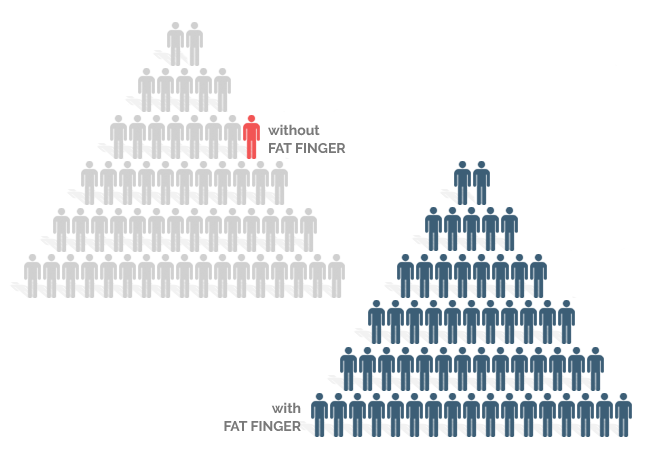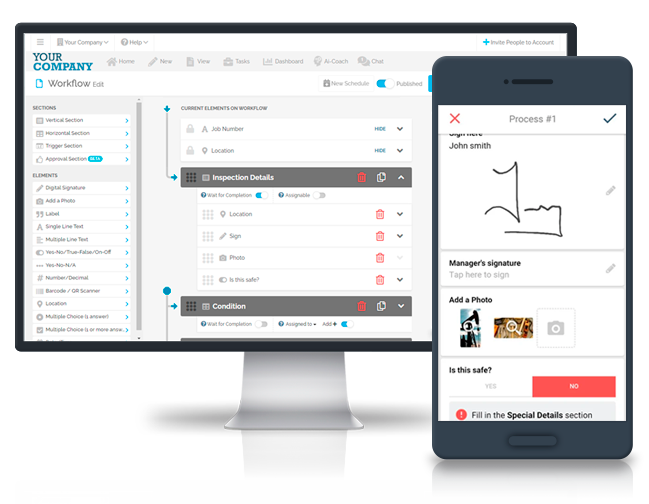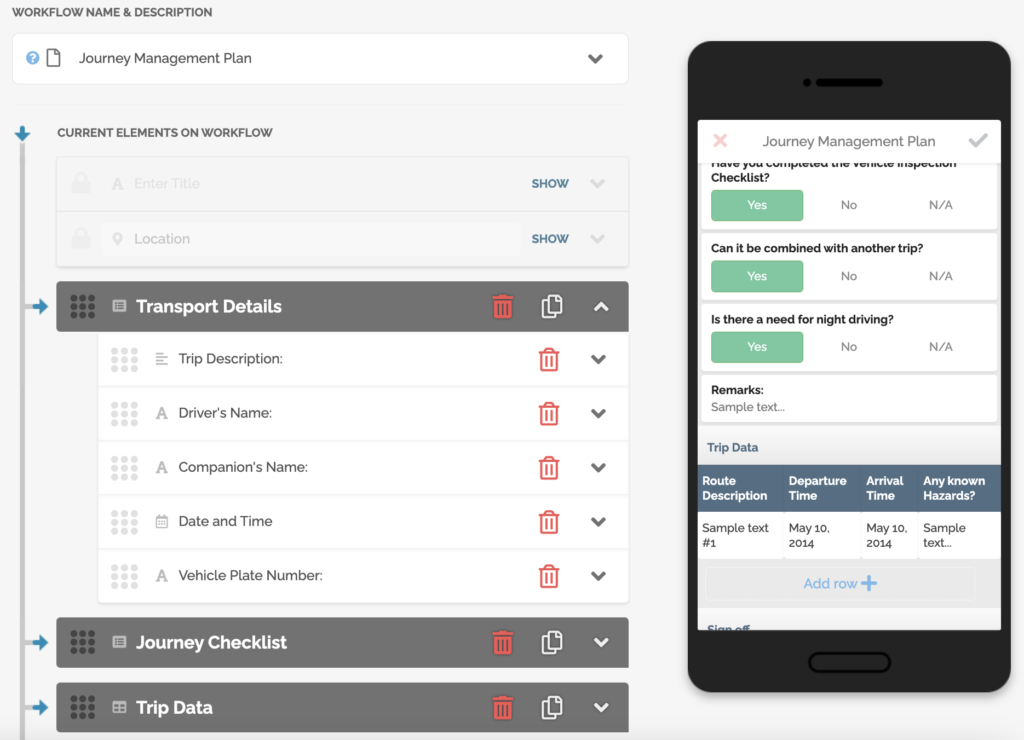A journey management plan is a system of safety measures followed during a road transport journey, especially one that involves driving for more than 4 hours. The programs are designed to identify and counteract risks such as driver fatigue, hazardous roadway conditions, and other obstacles.
By having a formalized journey management plan, industries can demonstrate their commitment to driver safety, protecting employees, and avoiding costly fines.
Table of Contents:
1.Journey Management and Its Importance
2.Challenges of Traditional Journey Management Plan
3.4 Components of a Journey Management Plan
4. Digital Journey Management Plan in Place- Your Way to Safety
Journey Management and Its Importance
A journey management plan is a critical tool for managing the transportation of goods throughout the supply chain. Providing a clear overview of the journey, allows the journey to be monitored and controlled more effectively, which can lead to substantial benefits in terms of cost, efficiency, and, most importantly, safety.
According to the National Safety Council’s 2017 study, crashes cost employers approximately $9.25 billion annually across all industries.
Moreover, research shows that human error is the root cause of accidents 70% of the time and is likely the cause 93% of the time.
A journey management plan is a tool used to increase safety visibility and control over the journey of goods. In particular,
1. Reduce transportation costs. By optimizing routes and schedules, journey management plans can help reduce the time and fuel required for travel.
2. Improve communication between different parties involved in transporting goods or persons. The journey management plan sets out the roles and responsibilities of each party, as well as the routes to be taken and the resources to be used. By clearly defining the roles and responsibilities of each party, the journey management plan helps to ensure that everyone is on the same page and that there is no confusion about who is responsible for what.
3. Helps drivers to navigate the roads safely and efficiently. By taking into account the specific route, weather conditions, and traffic patterns, journey management plans can help to reduce the risk of accidents and delays. In addition, journey management plans can also help to improve safety and security by reducing the risk of accidents and delays.
As a result, journey management plans are an essential tool for any company that relies on the efficient transportation of goods. Providing drivers with an up-to-date journey management plan can help ensure that everyone arrives at their destination safely and on time.
Challenges of Traditional Journey Management Plan
Journey management plans (JMPs) help ensure that employees are aware of the risks associated with their travel and have a plan in place in an emergency. Traditional journey management plans have long relied on paper-based checklists to ensure that all tasks are completed before beginning a trip. There are several disadvantages to using paper-based checklists, which can cause pain points throughout supply chain logistics.
1. Paper-based checklists are often misplaced or lost, which can cause confusion and delay in the event of an emergency.
2. Inaccurate paper-based checklists can lead to shipment delays, incorrect stocking levels, and other operational issues. Paper-based checklists also make it difficult to track progress and identify errors.
3. Paper-based checklists are challenging to update promptly, leading to employees being unaware of new or changed risks.
4. Paper-based checklists do not allow for real-time collaboration, making it challenging to coordinate a response in the event of an emergency.
Newer technologies, such as digital checklists in journey management, offer a more efficient and effective way to manage employee travel. Digital checklists can be easily updated in real time and shared with all team members automatically.
4 Components of a Journey Management Plan
Any journey, no matter how short, should be planned carefully to ensure safety. A journey management plan is a simple way to do this, and there are four key components: route selection, pre-trip planning, en-route monitoring, and post-trip debriefing.
1. Route Selection. Choose the safest route possible. This means taking into account things like weather conditions, road closures, and construction. If multiple routes are available, the one with the least risk should be chosen. Route optimization is finding the most efficient way to get from point A to point B. This can be done using various methods, including GPS, Google Maps, and even old-fashioned paper maps. The goal is to find the shortest, most direct route possible. Of course, this isn’t always possible (or even desirable). Hence, route optimization also considers traffic patterns, construction, weather conditions, and other factors that could impact the journey.
2.Pre-trip Planning. Once the route has been selected, it’s time to plan a pre-trip. This includes checking the vehicle for maintenance issues, packing an emergency kit, and letting others know the expected arrival time. A vehicle inspection checklist can help to ensure that vehicles are in good working order and meet safety standards.
3.Enroute Monitoring.Once on the road, it’s important to monitor conditions and be prepared to change the route if necessary. This may mean rerouting around traffic jams or accidents. It’s also essential to stop for breaks and stay aware of changing conditions. Enroute monitoring is vital because it allows organizations to manage risks proactively and respond quickly in the event of an emergency.
4. Post-trip debriefing. This allows organizations to learn from past travel experiences and adjust plans accordingly. By identifying what went well and what could be improved upon, organizations can make changes that will help to reduce the risks associated with the trip. In addition, post-trip debriefing provides an opportunity for the driver and his companion to share feedback about their travel experiences, which can help improve the overall quality of the journey management process.
Each component is vital in creating a safe and successful journey management plan. Considering all four components before setting out on any transport network can help ensure that our travels are optimized for safety, efficiency, and cost.
Digital Journey Management Plan – Your Way to Safety
Digital Journey management workflow provides a centralized platform for managing supply chain logistics and offers features such as real-time tracking and automatic notifications. These newer technologies available in FAT FINGER can help to improve the efficiency and effectiveness of JMPs and reduce the risk of paper-based checklists.
There are many advantages to having a digital checklist for journey management planning, as opposed to a traditional paper-based checklist. Perhaps the most essential advantage is that digital checklists are much more efficient and accurate. With FAT FINGER digital journey management checklists:
-Create customized journey management checklists that suit your transport safety needs. Remarks, corrective actions, and photos collected during trip planning and execution can be added to the workflow.
-Journey planners can easily see what tasks have been completed and which still need to be done. This is not always the case with paper-based checklists, which can often become lost or damaged.
-Digital checklists can be easily shared between journey planners, drivers, and other team members, making coordination and communication much more straightforward. Generate reports on the road and send them to relevant stakeholders via email, PDF, or web link. This way, everyone can stay up-to-date on the latest information.
-No matter where you are on the road, you can use our digital journey management checklist on any device with a web browser or FAT FINGER app. Digital checklists can be stored in secured cloud storage, so they can be accessed from anywhere, at any time.
FAT FINGER was created to solve the inefficiency and inaccuracy of traditional paper-based checklists. We make digital journey management planning more manageable than ever before, so you can focus on what’s important – your journey and road transport safety.
Sign up for a free trial today and see how FAT FINGER can change how you manage your journeys!
About FAT FINGER:
Ensure front-line teams do their work correctly every time. Drag & drop digital procedures that unlock operational excellence.
In seconds anyone can build and deploy enterprise-grade mobile applications using an easy drag-and-drop no-code builder.
FAT FINGER uses machine learning to coach app users in real-time to make safer and improved decisions.
Try building your digital procedure on FAT FINGER for free @ www.fatfinger.io
Journey reporting for everyone – Anytime and anywhere.
We empower EVERYONE to initiate and create positive change to improve the company’s safety journey records. The only way to keep up with the speed at which the world moves today is to empower everyone from the front-line worker to the executive.

Intuitive digital workflow – Paperless and powerful.
Every trips has its own potential hazards.With our intuitive workflow, you can quickly customize your data collection with images and annotations to create workflows with No-Code directly where work is done. Automatically generate a professional report with one click and share them with anyone.

Journey Data powerhouse – Keeping everything in one place.
Every single piece of information captured by your FAT FINGER users will feed your company analytics in real-time. Adopting FAT FINGER will give you show you the risky points of your operations and how to make them risk-free.








